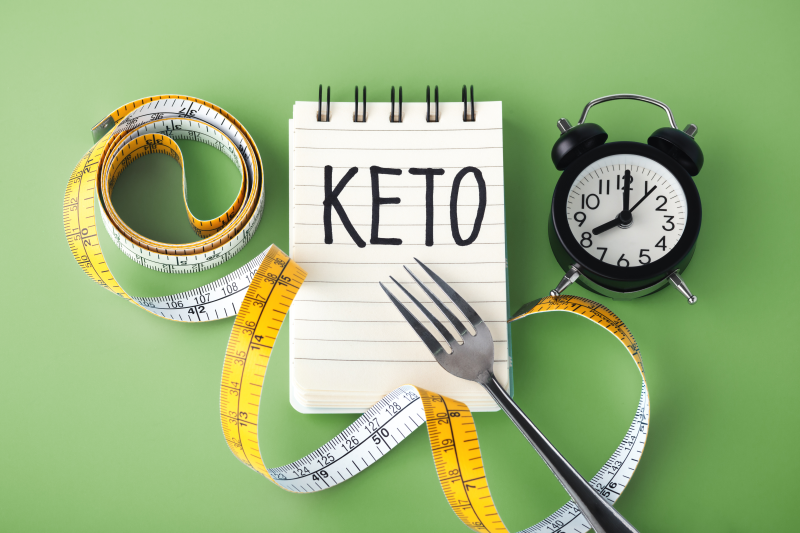At a glance
The shift into fat-burning happens at different rates for different people. Factors such as carb intake and diet history influence how quickly ketosis develops, and several testing methods and physical cues can help you know if you are in ketosis while guiding adjustments that support a smoother transition.
The keto diet is a low-carbohydrate diet that encourages the body to burn fat to generate energy instead of using sugars as a fuel source. This metabolic state is known as ketosis.
Ketosis has many health benefits, including weight loss, improved blood sugar control, and enhanced insulin sensitivity. But how do you know if you are in ketosis?
Discover natural signs of ketosis, the best ways to test for ketones, and how long it takes to adapt to fat-burning.
What is ketosis?
If available, glucose, which is derived from dietary carbohydrates and sugars, is the body’s main fuel source. If the body doesn’t receive enough carbohydrates, the liver is forced to convert fats into energy.
The breakdown of fats releases large amounts of high ketones, a group of organic acids that serve as a highly efficient fuel source when glucose is limited. When ketones enter your circulation and start to energize your cells, your body enters ketosis.
To trigger and maintain ketosis, most ketogenic diets aim to obtain around 70 percent of daily calories from fat, 20 percent from protein, and 10 percent from carbohydrates.
Though they’re commonly confused, nutritional ketosis is different from diabetic ketoacidosis, which is a serious medical condition characterized by extremely high levels of ketones and blood sugar.
Watch the video below to learn more about the signs of ketosis.
How do you know if you are in ketosis?
There are various ways to determine if you’re using ketones for energy.
One of the most reliable ways to know if your body is in ketosis is by utilizing ketone tests, which evaluate urine, breath, or blood concentrations of ketones.
There are various different ketosis test kits, including urine ketone strips that can be purchased over-the-counter (OTC) and measure ketone bodies in urine.
Breath ketone analyzers are also widely available and can be performed at home to measure acetone, one of the three primary ketone bodies.
In addition, at-home blood ketone meters using lancets and blood test strips or laboratory blood tests can be utilized to obtain the most precise results.
Listening to your body and monitoring ketosis symptoms, such as losing weight, improved energy levels, or a decreased appetite, can also indicate that you’re in ketosis.
Understanding ketosis vs ketoacidosis can help you interpret these test results correctly, particularly if you’re concerned about how high your ketone levels might go.

Are ketone tests accurate?
Urine and breath tests can be helpful when starting out on keto. However, these tests don’t measure metabolized ketones that your body uses for energy and only capture ketone bodies that are expelled.
“Urine or breath tests may not be very accurate once you’re adapted to ketosis,” explains Dr. Berg. “As soon as you start to burn ketones more efficiently, wasted ketones aren’t going to show up in your urine or breath, and those values could be zero despite you being in ketosis.”
While blood ketone levels will provide the most accurate results, blood ketone meters are invasive and can be expensive.

9 signs of ketosis
Though many at-home tests can show that your body is producing ketones shortly after starting a keto diet, they may not be reliable once you’re fully fat-adapted.
Fortunately, there are other ways to know if you’re in ketosis, including physical and emotional signs.
Here are nine signs and symptoms of ketosis.
1. Improved keto flu symptoms
Many keto dieters experience the symptoms of keto flu, such as fatigue, rashes, muscle cramps, and carb or sugar cravings, within the first few days of starting a low-carb diet.
These symptoms are often linked to carb withdrawal as the body searches for glucose to generate energy. In some cases, keto flu can also be caused by electrolyte imbalances, a temporary but common side effect of limiting carbohydrates.
Electrolyte supplements can help support your body during the transition to a ketogenic diet. However, if you’ve experienced the low-carb flu and notice symptoms dissipating, it’s a good sign that you have entered ketosis.
2. Weight loss
Glucose requires water to be deposited in glycogen stores in the liver and muscle tissues.
When you restrict carbohydrates, glycogen reserves are quickly depleted, which explains why keto dieters often shed several pounds of water weight shortly after starting a keto diet.
A study published in StatPearls found that “Individuals on a ketogenic diet typically experience rapid weight loss, often up to 10 pounds in 2 weeks or less. This initial weight loss is attributed to the diet’s diuretic effect; the loss of water weight is followed by fat loss.”1
After shedding water weight, keto dieters usually lose body fat consistently at around 1 to 2 pounds weekly, which is a hallmark sign that your body is in ketosis.

3. Increased energy
Most individuals report increased and sustained energy levels once they have entered ketosis.
This is likely due to ketones being a preferred and longer-lasting fuel source for the body than glucose. Fat provides double the energy of carbohydrates and is readily available from dietary fat sources and the body’s own fat reserves.
Contrarily, a high-carb diet causes blood sugar fluctuations, often leading to tiredness after eating and triggering cravings for more carb-rich foods to boost energy.
4. Improved inflammation and less pain
Those who are in ketosis can experience less pain and improved symptoms from inflammatory conditions, such as arthritis, autoimmune diseases, and diabetic neuropathy pain.
Ketones are anti-inflammatory molecules that help reduce the production of reactive oxygen species. These unstable molecules cause oxidative stress and inflammation, which worsens inflammatory disorders and explains why improvements may be a sign you entered ketosis.

5. Slimmer waistline
Many people begin to notice that their clothes are loose around their waist a few weeks after starting keto.
Those who are overweight or insulin-resistant commonly develop a fatty liver, which causes fat to accumulate in the midsection and leads to a distended belly.
When your body runs on ketones, it breaks down the visceral fat around the liver, slimming your waistline.
6. Improved cognition
Refined carbohydrates trigger the release of insulin, which leads to blood sugar fluctuations that negatively affect the brain.
Low-carb diets such as keto push the body to use ketones, a more efficient fuel source for the brain than glucose. If you’re in ketosis, you’ll likely experience less brain fog, have better memory, and learn more effectively.
A study published in Nutritional Neuroscience found that the ketogenic diet improved cognitive function, including reference memory, working memory, and attention while lowering the risk of age-related neurodegeneration.2
7. Satisfied after eating
Many keto dieters report feeling more satisfied and experiencing less hunger after eating meals.
The cells of those who are insulin-resistant from consuming too many carbs and sugars can’t effectively absorb blood sugar.
This leaves cells starving despite plenty of fuel being available in the blood, triggering cravings that can lead to incessant grazing and snacking between meals.
Ketosis stabilizes blood sugars, which reduces insulin production and improves insulin sensitivity. This explains why those following keto typically experience less hunger and cravings than individuals consuming high-carb diets.

8. Better mental health
Keto dieters may notice an improvement in depression and anxiety symptoms when entering ketosis.
Ketosis has been shown to increase gamma-aminobutyric acid (GABA), a neurotransmitter in the brain that blocks and slows signals sent from other neurotransmitters, promoting calmness.
Additionally, a high fat diet can boost dopamine levels, widely known as the feel-good hormone, that helps regulate feelings of pleasure and satisfaction.
9. Appetite suppression
The ketogenic diet’s appetite suppressant effect is another indicator that you may have entered ketosis.
Those who are fat-adapted and use ketones efficiently typically have reduced hunger and can go longer without eating between meals. This not only helps you lose weight but also promotes hormonal balance and metabolic health.
A study published in the Current Opinion in Clinical Nutrition and Metabolic Care found that the keto diet suppresses ghrelin, a hunger-regulating hormone, which can help curb cravings.3

How long does it take to get into ketosis?
How long it takes to get into ketosis depends on how many carbohydrates you consume and your previous dietary habits. However, most keto dieters will enter ketosis within two to three days.
In the first few days of following a low-carb diet, the metabolism burns through available glucose and glycogen stores in the liver and muscle tissues before switching to fat-burning.
Those who follow a very low carbohydrate diet by restricting carb intake to 20 grams may enter ketosis more quickly than those who consume 50 grams of net carbs daily.
However, if you consumed a high-carb diet before starting keto, it’s important to note that it can take significantly longer until you enter ketosis and become fully fat-adapted.
Key takeaways
- Ketosis is a metabolic state in which the body shifts from using glucose to using body fat as fuel.
- The rate at which you enter ketosis depends on factors such as carb intake, glycogen levels, and previous dietary habits.
- There are several at-home ketone test kits, such as urine strips, breath analyzers, or blood ketone meters, along with physical and emotional cues, that can help you know if you are in ketosis.
- Natural signs of ketosis may include steadier energy, reduced appetite, improved mental clarity, reduced keto-flu symptoms, a better mood, and initial water weight loss, followed by gradual fat loss.
FAQ
1. How do you know you are in ketosis?
Various signs can indicate you are in ketosis, such as weight loss, reduced inflammation and pain, and improved energy and cognition. You may also have a reduced appetite, feel more satisfied after eating, and experience better moods.
2. How long does it take to get into ketosis?
On average, keto dieters can get into ketosis within two to three days of starting keto. However, this depends on how low your carbohydrate intake is and how much glycogen stores your body contains.
Some individuals, especially those who consumed a high-carb diet before starting keto, may take several weeks to become fully adapted to fat-burning.
3. Can ketosis make you smell bad?
Yes, bad breath, widely known as keto breath, is a common side effect of ketosis and is often characterized by an odor similar to nail polish remover. This occurs as the body burns acetone, one of the primary ketones released during fat burning.
4. Do you need a ketone test to know if you’re in ketosis?
No, a ketone test isn’t required to know if you’re in ketosis. Ketone tests can be beneficial when first starting the ketogenic diet.
However, urine and breath tests may not be reliable once you’re adapted to ketosis as they only measure the ketones that aren’t being metabolized by the body.
Sources
- https://www.ncbi.nlm.nih.gov/books/NBK499830/ ?
- https://pubmed.ncbi.nlm.nih.gov/36354157/ ?
- https://journals.lww.com/co-clinicalnutrition/Fulltext/2021/07000/Ketogenic_diets_and_appetite_regulation.14.aspx ?


















